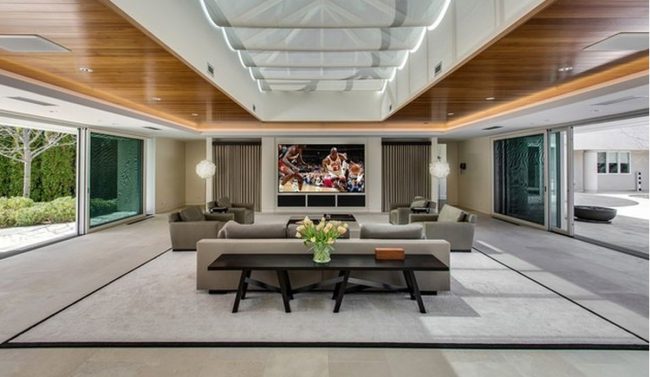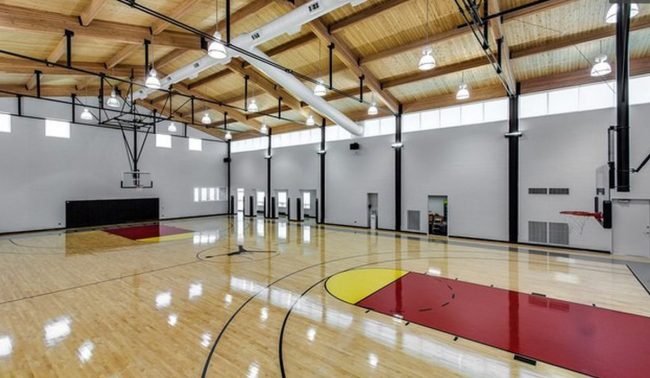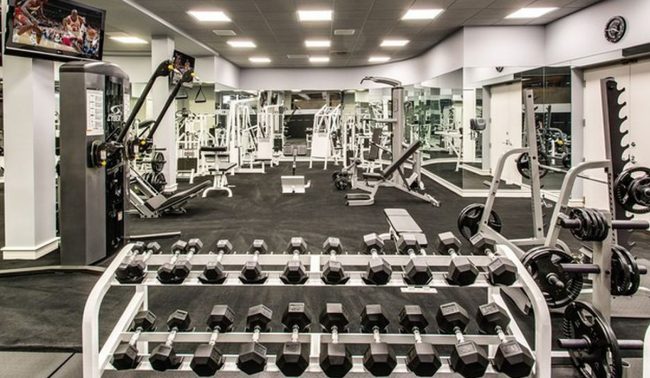He’s one of the most famous athletes of all time, immortalized by a statue at the United Center, the man who could do absolutely anything on the court.
But for six years, Michael Jordan has been unable to sell a house.
Jordan and his first wife, Juanita, moved into a custom-designed home in north suburban Highland Park in 1995 and raised their three children there until their divorce in 2006.
Jordan got the mansion in the split, but by then he’d already put the Chicago area in his rear view mirror: His career with the Bulls ended after the 1998 season, and after a brief comeback with the Washington Wizards in 2001-2003, he moved on to an ownership role with the Charlotte Bobcats in 2006.
In 2012 he listed the home for $29 million. That ended up being out of sync with what the North Shore market could bear.
Four price chops and many flashy marketing tricks later, the house sits unsold — occupied only by the staff, which His Airness still employs to keep it looking fresh.

(Credit: Zillow)
Compass’ Katherine Malkin said the 30,000-square-foot house on seven acres is now asking just under $14.4 million. Malkin, formerly of Baird & Warner, has listed the mansion for its entire time on the market.
Stephen Shapiro of the Westside Agency, a Los Angeles-based luxury brokerage, said “almost without exception” people won’t pay more for a house just because it’s owned by a celebrity.
“But you know who tends to think a property is worth more because a celebrity lived there? The celebrity trying to sell it,” Shapiro said.
By 2013, Jordan might have come to terms with that reality. He announced he was putting the house up for auction. The minimum bid of $13 million was never reached.
Then, in 2015, a team from the Los Angeles-based brokerage The Agency, with a specialty in selling celebrity homes, stepped in to help sell the house.
Under the stewardship of this team, led by Agency CEO Mauricio Umansky and Kofi Nartey, the effort to sell the house took on a new panache. Umansky told TMZ in May 2015 the home would be sold within a few months.
“Someone will be enjoying Christmas in Jordan’s house,” he said.
Shortly after taking over the listing, Nartey told Maxim a buyer would receive a pair of every version of Air Jordan sneakers ever made. The asking price was tweaked to a number whose digits added up to 23, Jordan’s jersey number for most of his hoops career.
Gimmicks and bombast didn’t do the trick. And The Agency ultimately was as successful in selling the mansion as MJ was in his brief foray into baseball in the mid-1990s. Or during his comeback with the Wizards.
In summer 2016, Nartey was recruited by Compass and is no longer involved with selling the property.
The higher profile the house enjoyed while Umansky and Nartey were marketing it led to a culture clash at times, Malkin said.
“Some of that big publicity also brought big baloney,” she said, noting prospective “buyers” frequently called with stories of some connection to Jordan that didn’t check out.
“I probably got 30,000 calls from people who were full-on crazy.”
Nartey declined to comment for this story and Umansky did not respond to requests for comment.

(Credit: Zillow)
Berkshire Hathaway HomesServices Koenig Rubloff’s Missy Jerfita and Michael Mazzei were among those taken on an invitation-only tour of the house several years ago, part of an effort by Malkin to drum up interest from buyers who might have relationships with local high-end agents.
“It’s absolutely stunning on the inside,” Mazzei said. A set of brass doors leading to a study and an intercom system with labels on buttons like “Michael’s office,” were part of what solidified the sense that the basketball legend really inhabited the place, he said.
Jerfita said she doesn’t know of a house anywhere in the area that’s been on the market as long as the Jordan house.
“It’s kind of stale now,” she said. “A house can get stigmatized if it’s on the market too long.”
It doesn’t help that there aren’t a lot of houses to compare it with.
Among properties that have been on the market recently, perhaps of the closest comparisons would be a 30,000-square-foot home on 70 acres about 15 miles west in Barrington Hills.
It hasn’t fared much better. It listed for $20 million in 2014, and its ask now stands at $14.9 million, according to Zillow.
The median sale price in Highland Park in March was $672,000, according to Coldwell Banker.
The area’s highest-priced homes are mostly clustered along the shores of Lake Michigan, a couple of miles east of the Jordan estate. The highest closing price for a home on record in Highland Park, according to Crain’s, was a lakefront estate that sold for $17 million in 2006 in a tonier part of the suburb of 30,000 about 25 miles north of Downtown Chicago.
“Buyers at that level in that area tend to want to be closer to the lake,” Jerfita said.
The scarcity of comparable properties can only add to the difficulty of selling a uniquely lavish house, Jerfita said.
Not so in Los Angeles, where mega-mansions seem to sprout up every day.

(Credit: Zillow)
Few know that more intimately than Shapiro, who in 2014 sold a 14,000-square-foot mansion built for Tom Brady and his wife Gisele Bündchen.
Asked if he’d heard of a celebrity home languishing on the market for six years, he paused and noted a home owned by singer Gwen Stefani has been on the market for about a year and hasn’t yet found a buyer.
But pop star money is one thing, and billionaire money is quite another.
“The billionaires I deal with, if they have a house that’s not producing for them they get rid of it,” Shapiro said. “Everything will sell at a price. It just might need to go down even more.”
